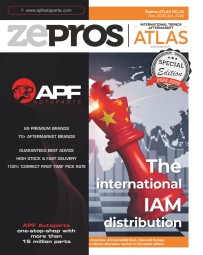
New Car Dealerships : The tough road towards an aging car fleet

The evolution of the fleet and contractual obligations leaves new car dealers with no choice. They must take charge of their brand’s vehicles over five years old or expand into multibrand maintenance, something they have always avoided due to business culture and contractual obligations. This shift is laden with numerous challenges
European car distributors and their aftersales activities face significant hurdles. The evolving European legislation is pushing car dealers into the uncharted territory of a new commercial agent status. Additionally, the rise of fully electric vehicles (BEV) is expected to lead to a decline in after-sales services, particularly for electric vehicles, impacting their workshops before others.
A slide in after-sales value
The aging of the vehicle fleet and the growing presence of electric vehicles in car dealers’ workshops are reshaping the dynamics of after-sales value. The shift towards older vehicles is evident, according to figures on the French market from GiPA, a company specializing in aftersales research. This trend is observable in mature markets worldwide, including Europe.
From 2021 to 2025, the value of the aftersales market is expected to decrease by almost 10% for vehicles less than five years old, while it is projected to increase by more than 12% for vehicles aged 5 to 9 years. This pattern is likely to impact the potential growth of an aging fleet, depending on the actual numbers and ages of full-electric vehicles (BEV) following the anticipated upward trajectory set by the end of internal combustion engine (ICE) vehicle sales in Europe by 2035.
For new car dealers, who increasingly rely on after-sales activity to sustain the profitability of their companies, there is no viable alternative. They must swiftly attract “ICE customers” with five- to nineyear-old cars and, by 2030, target those with cars over ten years old. While they excel in company fleet maintenance, a market that continues to grow, fleet managers, guided by necessary CSR (Corporate Social Responsibility) strategies, are compelled to transition their fleets to electric.
Sub-dealers have alternative solutions
Car distributors must focus, in the immediate future, on the most accessible sector: their own brand’s five to nine-yearold cars. However, this approach may pose a challenge as it involves encroaching on the territory of their traditional local partners, specifically approved level 2 garages (sub-dealers) in markets where they still hold significance. Despite recognising that many of these agents may lose their brand identity, they are unlikely to step aside easily for their dealers. These agents maintain a high level of trust with their customers. Even if they no longer officially represent the brand, they are still perceived as specialists for that brand. Consequently, they may bring their customers with them into one of the multi-brand networks, presenting an opportunity to offer an appealing price/service ratio to their longstanding customers.
Agents who have been abandoned or are concerned about being abandoned are strategic opportunities for multi-brand networks facing a dual challenge. On one hand, they need to swiftly take over the maintenance and repair of recent vehicles with numerous technological advancements. Simultaneously, they must organise themselves to resist the anticipated offensive from dealers on their territory. Multi-brand networks eagerly welcome these well-trained and enthusiastic recruits. They are accustomed to brand discipline and are structured to handle diverse activities, including new and used sales, bodywork repairs, or car financing. They may also harbour feelings of exclusion by both their dealer and their manufacturer, adding an additional layer of complexity to the situation.
Culture shocks

In the realm of mechanical maintenance and repair, numerous car distribution groups are exploring an alternative path for diversification: the development of multi-brand franchises. These franchises have a historical focus on maintaining older vehicles in the fleet and often specialise in tyre services. Notably, tyres remain the primary and enduring reason for customers to visit a workshop.
Why are they considering this outsourced approach over their own workshops? Firstly, the obstacles to outright integration are abundant. Car dealers’ workshops possess specialised single-brand tools and staff experienced in processes defined and monitored by the manufacturers of the respective brands. These workshops are already engaged in warranty work, recalls, and the classic maintenancerepair activities specific to the represented brand(s). Clear cultural and organisational differences make it challenging to accommodate both brand-specific and multi-brand repairs within the same workshop.
Additionally, accommodating the brand’s older vehicles proves difficult for a dealer’s workshop. The prices of original parts set by manufacturers, the required processes, imposed training, and labour rates dictated by the overall costs of representing the brand contribute to making their services more expensive than those of multi-brand workshops. This, in turn, frustrates customers who readily compare the more competitive offers from independent garages. A dissatisfied customer, regardless of the vehicle’s age, negatively impacts the Net Promoter Score (NPS), the basis for calculating end-of-year bonuses and, consequently, after-sales profitability. Seeking equivalent-quality parts elsewhere is also impractical, as a similar penalty applies if the ratio of original parts to vehicles of the brand decreases, resulting in a reduction in bonuses.
In summary, for new car dealers, the mandatory transition to multi-branding and the challenges posed by an aging fleet are paved with numerous difficulties.






